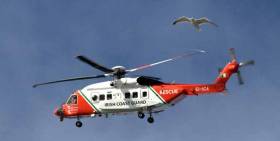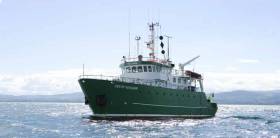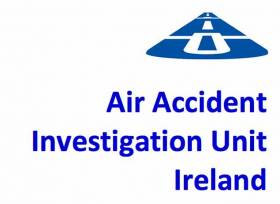Displaying items by tag: R116
Meitheal: The Story of a Search - Documentary on Rescue 116 Crash Due to be Broadcast by RTÉ
“They were our friends, our colleagues...it was just hard to comprehend that we were trying to rescue the rescuers themselves...”
These are some of the comments made by members of a Mayo community, recorded by filmmaker Fergus Sweeney, for a documentary he has made in the aftermath of the crash of Irish Coast Guard helicopter Rescue 116.
Sweeney, nephew of Blacksod lighthouse keeper Vincent Sweeney, found himself at the heart of the initial response when the Sikorsky S-92 was reported missing in the early hours of March 14th, 2017.
All four crew, Capt Dara Fitzpatrick, Capt Mark Duffy and winch team Ciaran Smith and Paul Ormsby, died after the helicopter clipped Blackrock island while en route into Blacksod to refuel.
 “Meitheal - The Story of a Search” is an independent film by cameraman and filmmaker Fergus Sweeney. The documentary tells the story of how the small rural community of Erris on the Irish Westcoast found themselves at the heart of a 42 day search for the crew of Irish Coastguard helicopter Rescue 116.
“Meitheal - The Story of a Search” is an independent film by cameraman and filmmaker Fergus Sweeney. The documentary tells the story of how the small rural community of Erris on the Irish Westcoast found themselves at the heart of a 42 day search for the crew of Irish Coastguard helicopter Rescue 116.
A search that would lead the community on a journey of grief, emotion and Inspiration.
The bodies of Capt Fitzpatrick and Capt Duffy were recovered, but the winch crew are still missing.
In the documentary, community members say their search for the two men continues.
Sweeney records the impact of the crash on the locality, and interviews local Coast Guard members, including Michael Hurst and those who provided daily sustenance during the 40-day effort in the community hall at Eachléim.
The helicopter had been tasked to provide top cover for the Sligo-based Rescue 118 helicopter in a medical evacuation in the Atlantic.
The "probable cause" of the crash was identified by the Air Accident Investigation Unit as a combination of the helicopter's altitude, poor weather and the crew being unaware of a 282ft obstacle on the flight path of a pre-programmed route they were using.
A further 12 contributory causes were identified by the AAIU in the 350-page report.
They included "serious and important" weaknesses with how CHC Ireland managed route testing and mitigation; "confusion” at State level on responsibility for oversight of search and rescue operations; the positioning of a route waypoint almost "coincident" with Blackrock Island; and "crew members' likely hours of wakefulness at the time of the accident".

Meitheal: The Story of a Search is due to be broadcast on RTÉ 1 television on Tuesday, August 16th, at 10.30 pm.
Search Continues for Missing Crew of R116
Remote Operations Vehicle (ROV) operations, conducted by Marine Institute specialists on-board the Granuaile in conjunction with An Garda Síochána and the Air Accident Investigation Unit continued overnight and are ongoing. Wind has freshened overnight, which may constrain certain elements of the proposed search until Sunday, but conditions remain favourable for time being. Air, surface and shoreline searches are ongoing today, supported by Coast Guard, RNLI and Civil Defence volunteers. The Shannon based Coast Guard helicopter will conduct aerial searches later today. The Air Corps are also supporting the search.
Also the Coast Guard wishes to request all mariners, particularly those not participating on Saturday 8th April, to continue to keep a good lookout for any material associated with R116 and report any sightings to Malin Head Coast Guard Co-ordination Centre.
The AAIU in consultation with An Garda Síochána, the Navy, the Coast Guard, the GSI and the Marine Institute wish to advise that following initial Remote Operated Vehicle (ROV) operations the wreckage of R116 has been positively located on the sea bed on the Eastern side of Black Rock, at a depth of approx. 40m.
Operations are continuing but are weather dependent.
AAIU Statement on Investigation into the Loss of R116
The AAIU wishes to extend its sincere sympathies to the families and friends of the crew of R116.
The Chief Inspector of Air Accidents, Mr. Jurgen Whyte, in consultation with the appointed Investigator-in-Charge, Mr. Paul Farrell, wishes to make the following statement.
An AAIU investigation into the circumstances of the loss of R116 is underway. As with all AAIU investigations, this Investigation will be evidence based.
The Investigation has been working with the Garda Síochána, Coast Guard, Irish Air Corps, the Irish Marine Institute, and many local persons and agencies with the primary objective of locating and recovering the missing crew members.
In addition, the AAIU is anxious to recover and examine as much wreckage as possible, and in particular to recover the combined voice and flight data recorder (“black box”). The AAIU, in accordance with international convention, has an Accredited Representative from the US National Transportation Safety Board (as state of design and manufacture); that representative has advisers from the US Federal Aviation Administration and the aircraft manufacturer. The AAIU has also received assistance, support and advice from the UK Air Accidents Investigation Branch two of whose inspectors attended Blacksod.
A significant amount of wreckage has been recovered from the sea and this has been logged and will be brought to the AAIU wreckage facility in Gormanston, Co Meath, for detailed examination.
Furthermore, the AAIU has visited Black Rock Light House, on the approaches to Blacksod bay, which is close to the last recorded position of the helicopter. Some helicopter wreckage has been recovered from the general area of Black Rock Light House. This wreckage is primarily from the tail area of the helicopter. At this early stage in the investigation it is not possible to be definitive about the exact nature of damage to the recovered wreckage or indeed the circumstances of the accident. However, there appears to be marks on some of the recovered wreckage which are consistent with the tail of the aircraft contacting rocky surfaces on the Western end of Blackrock.
The Investigation has not yet definitively identified the initial point of impact.
Equipment aboard surface search vessels has detected a signal which is believed to be from the underwater locator beacon attached to the aircraft’s “Black Box”. This signal points toward an area which will be the focus of further, multi-agency investigation activities at the earliest opportunity, subject to weather.
































































